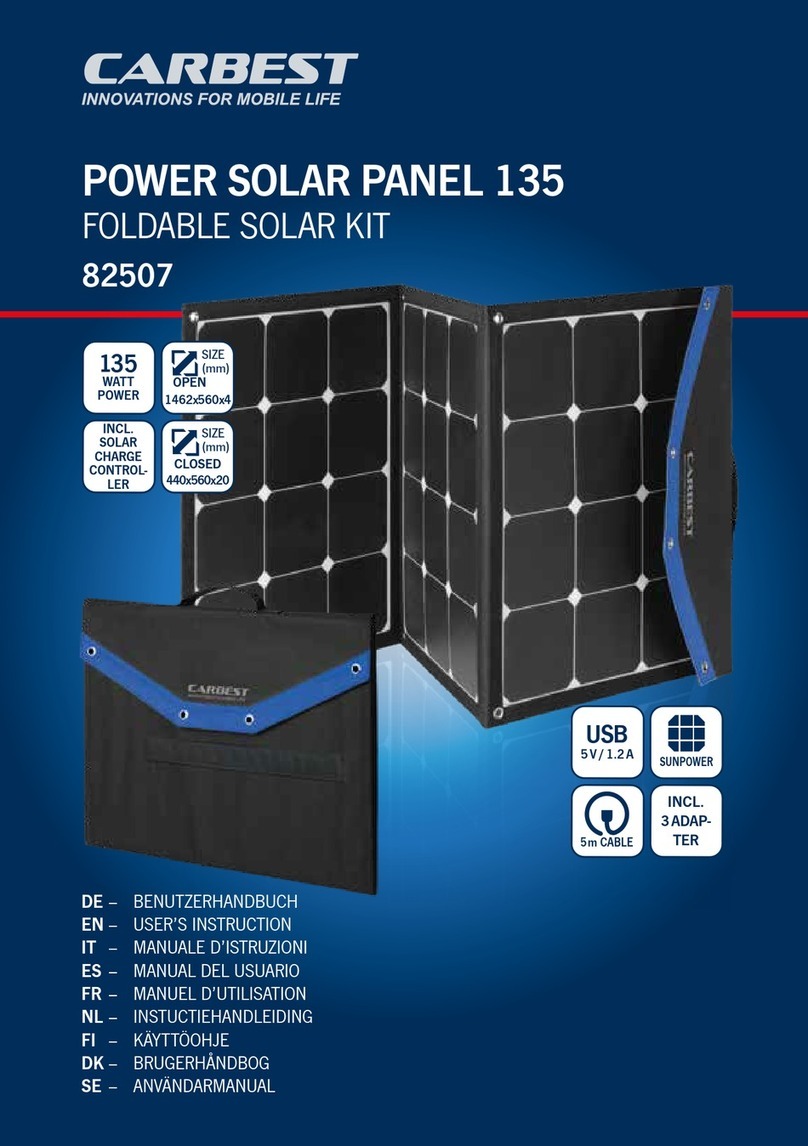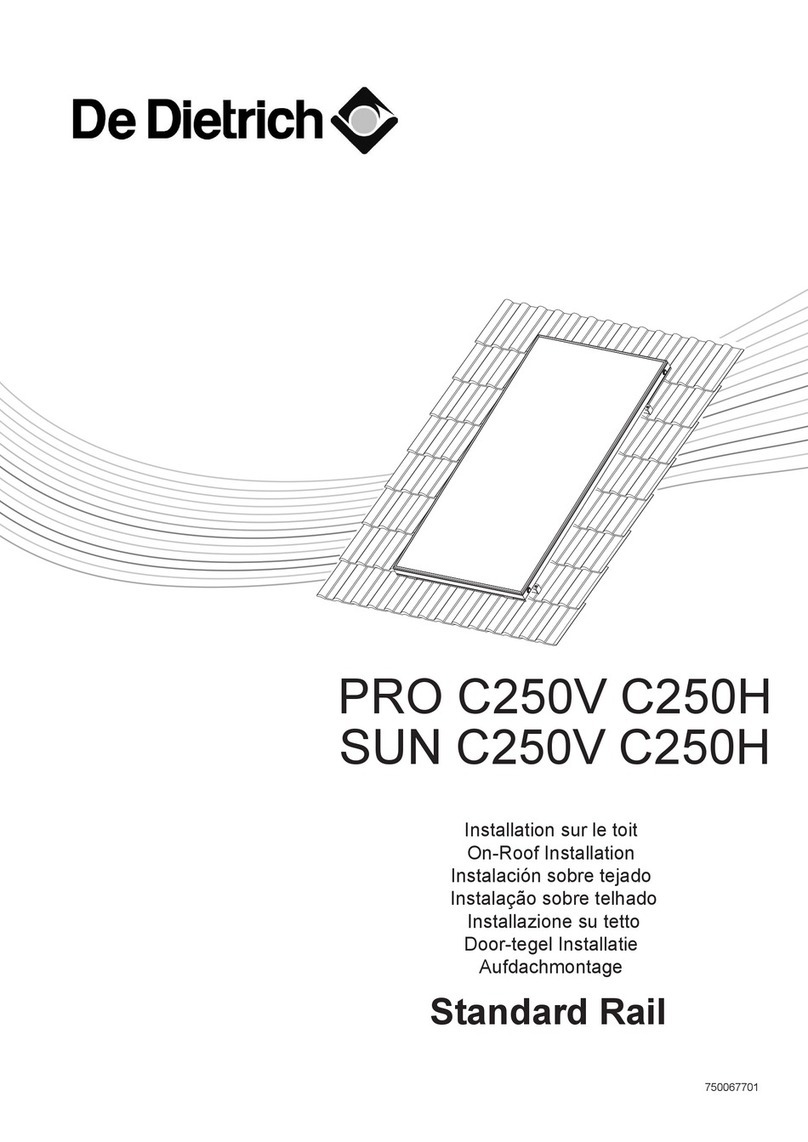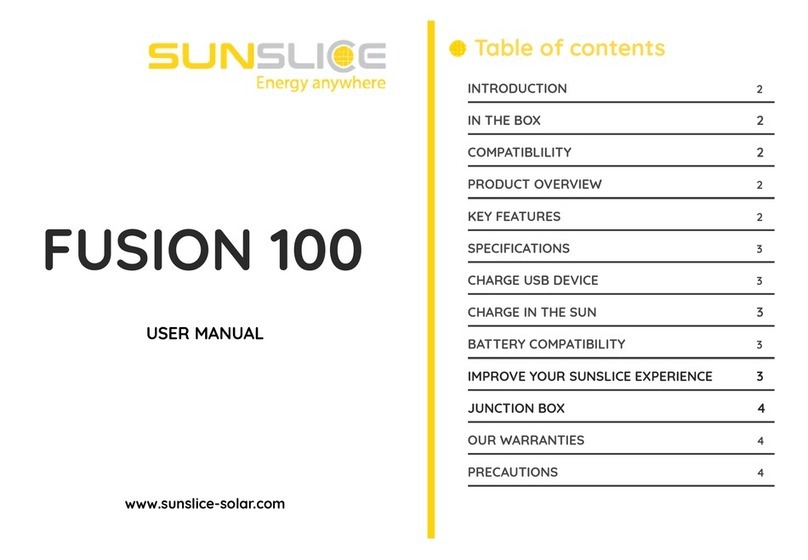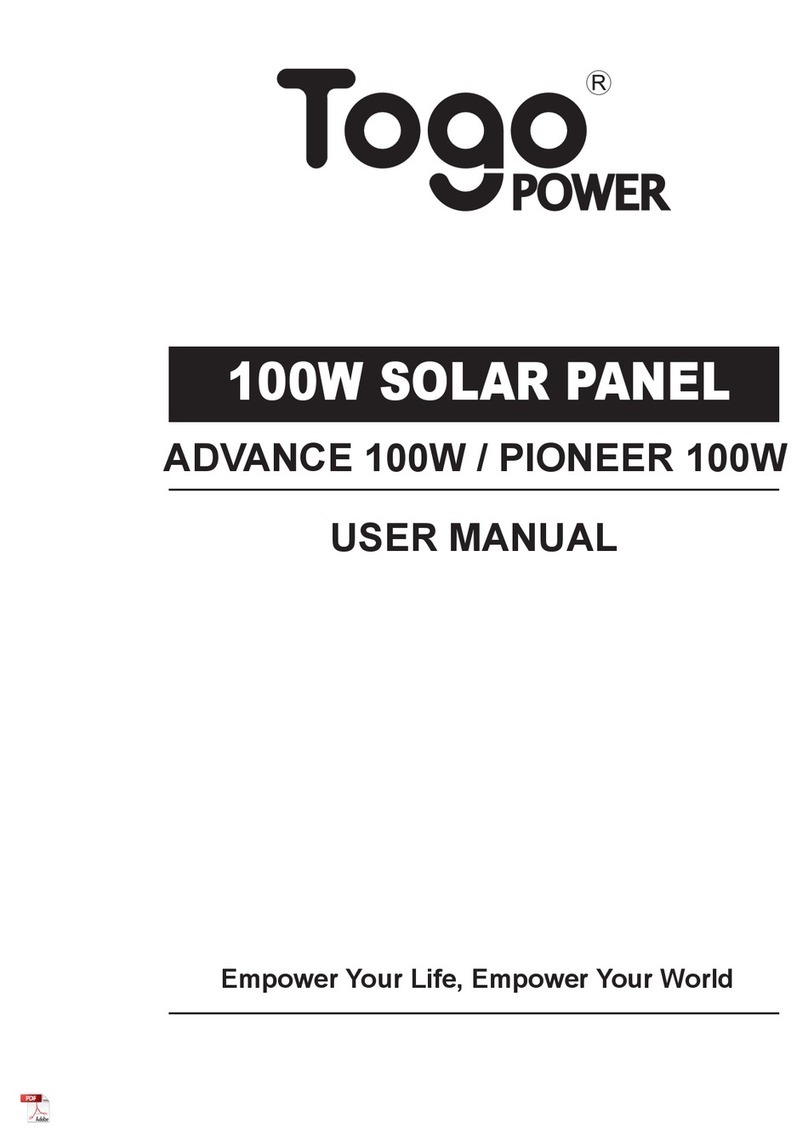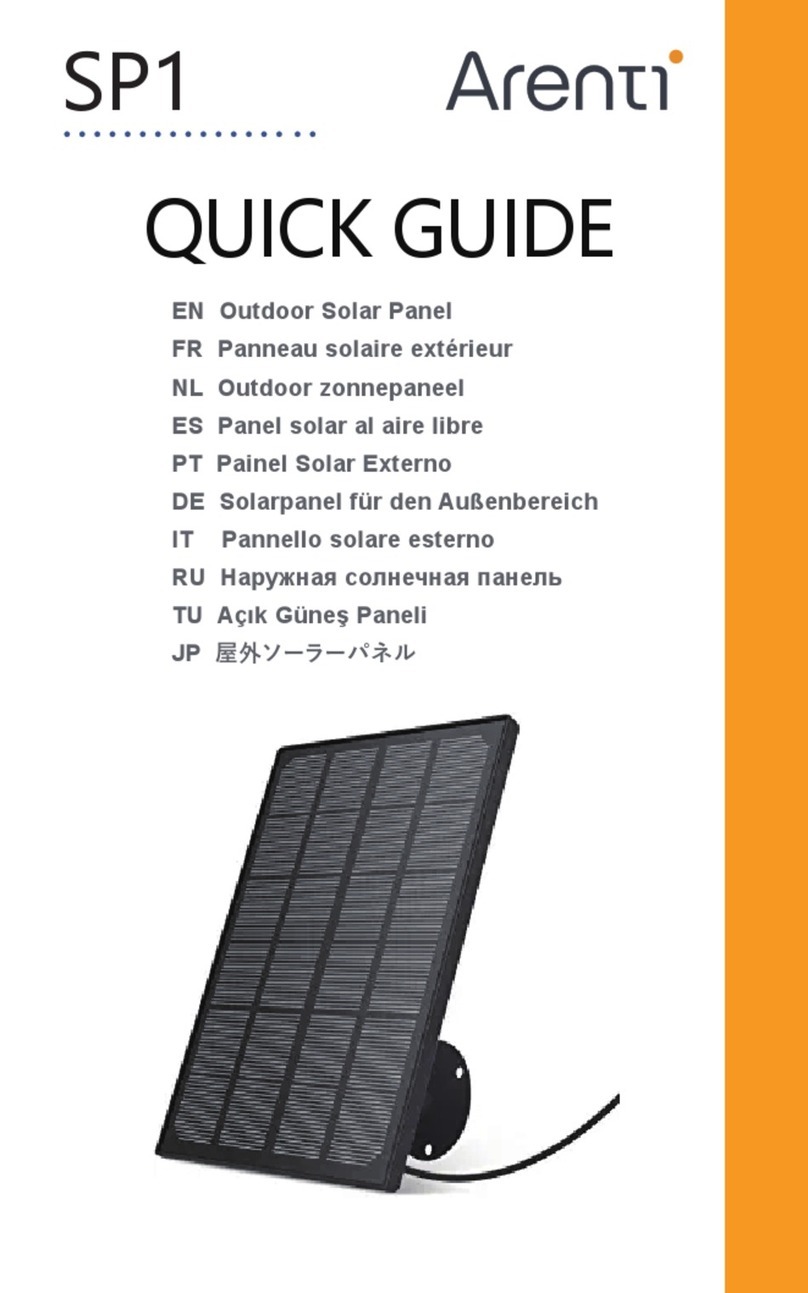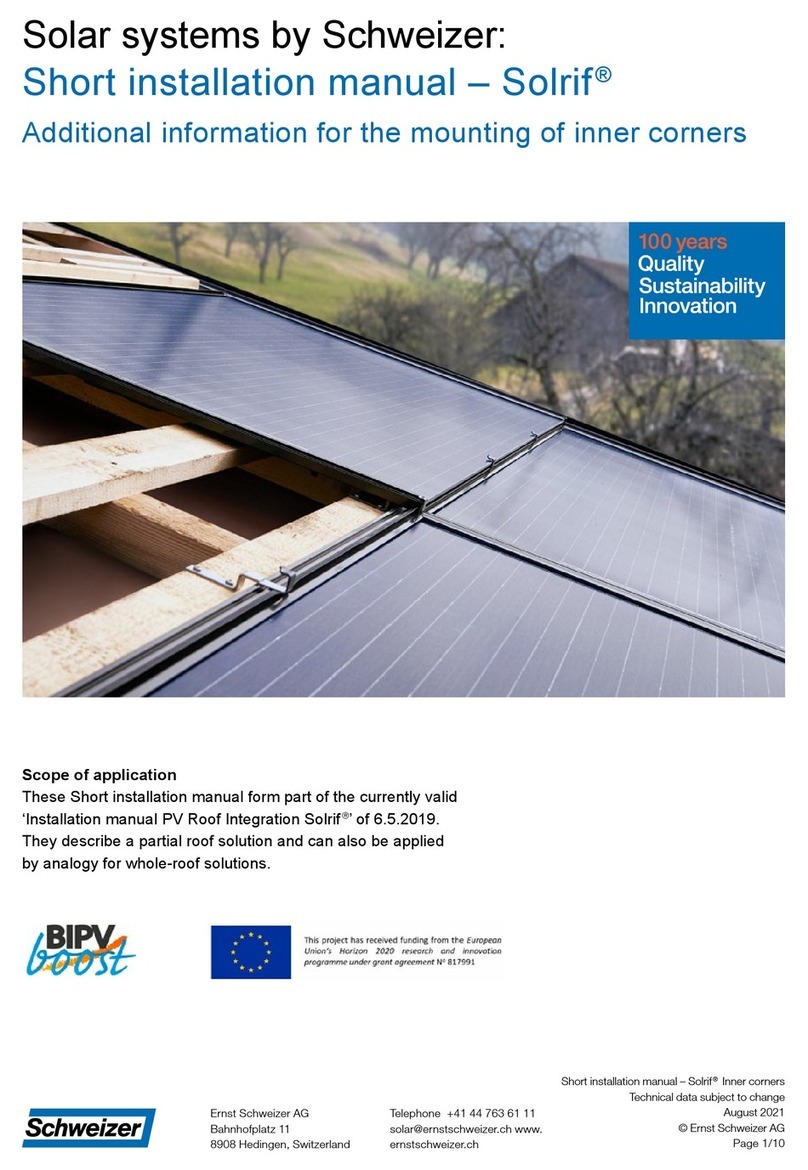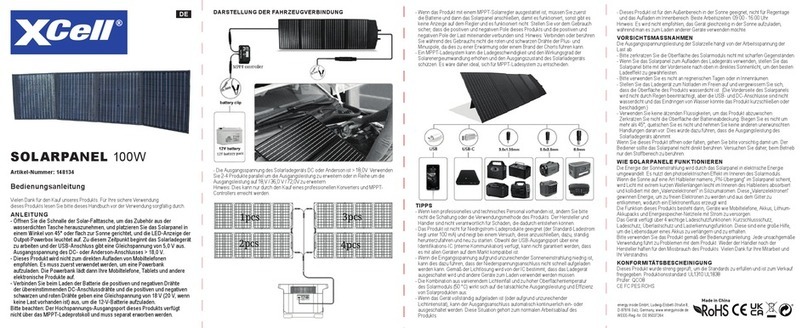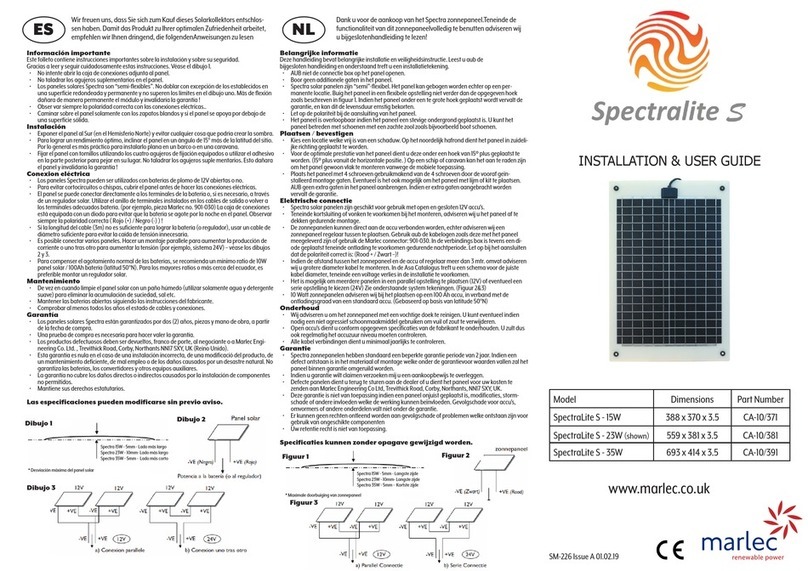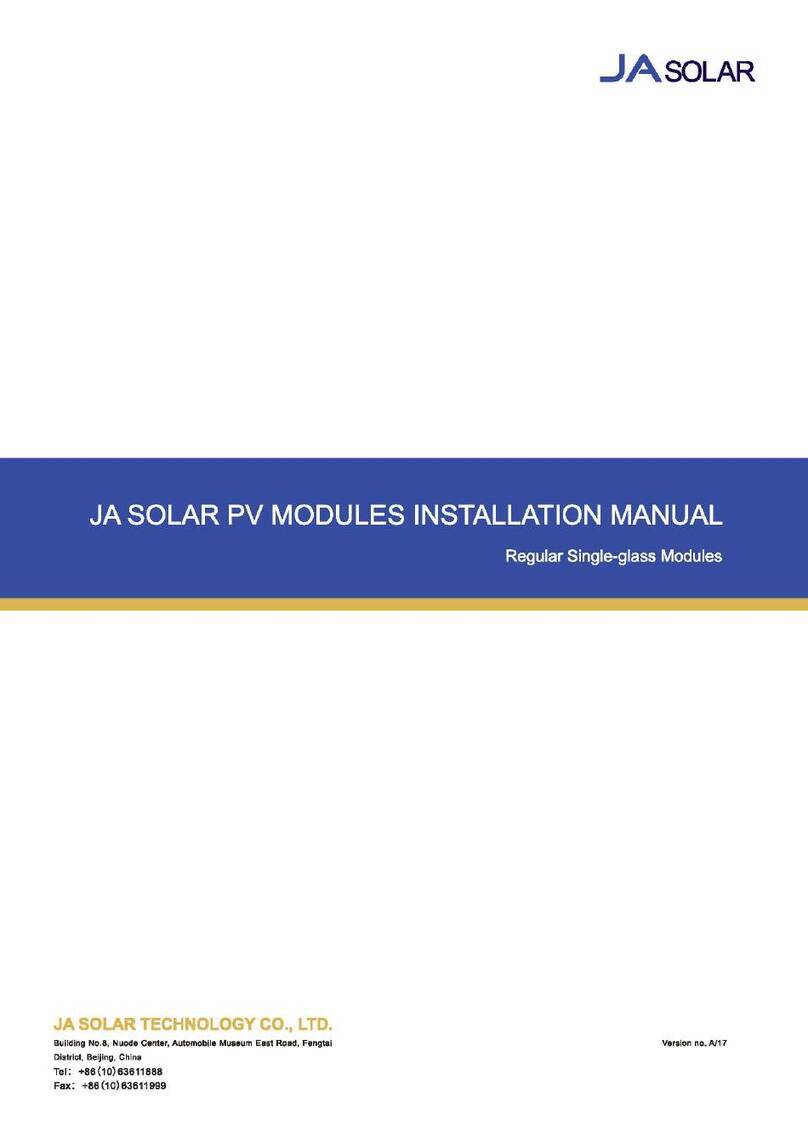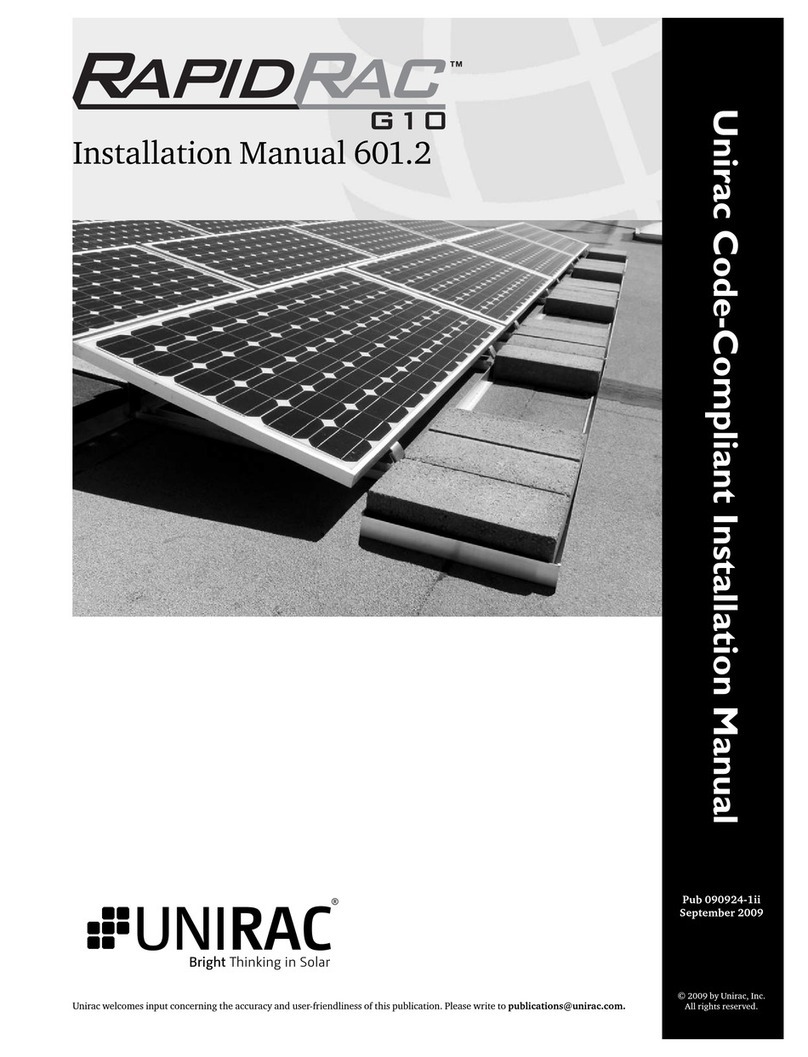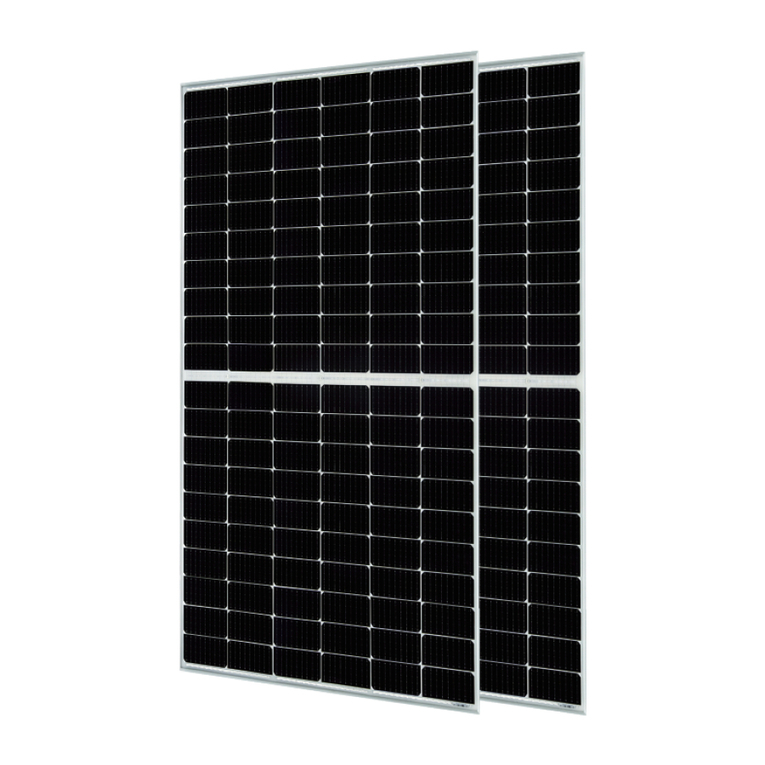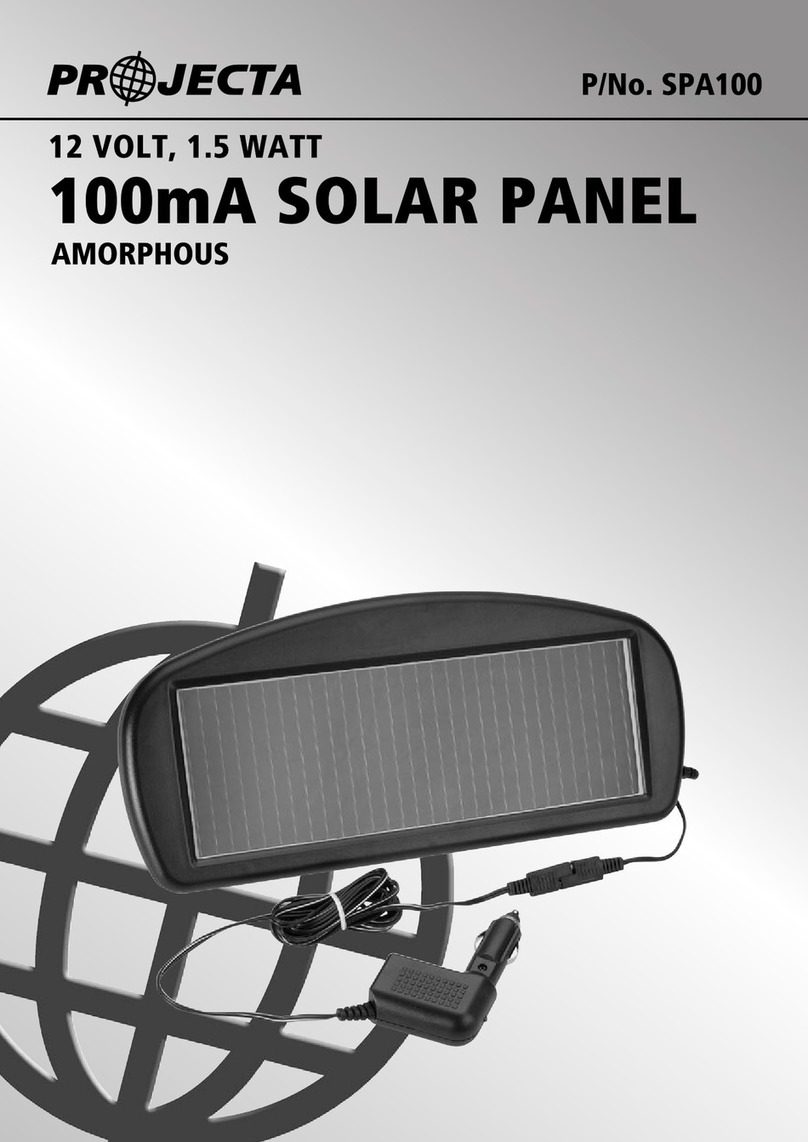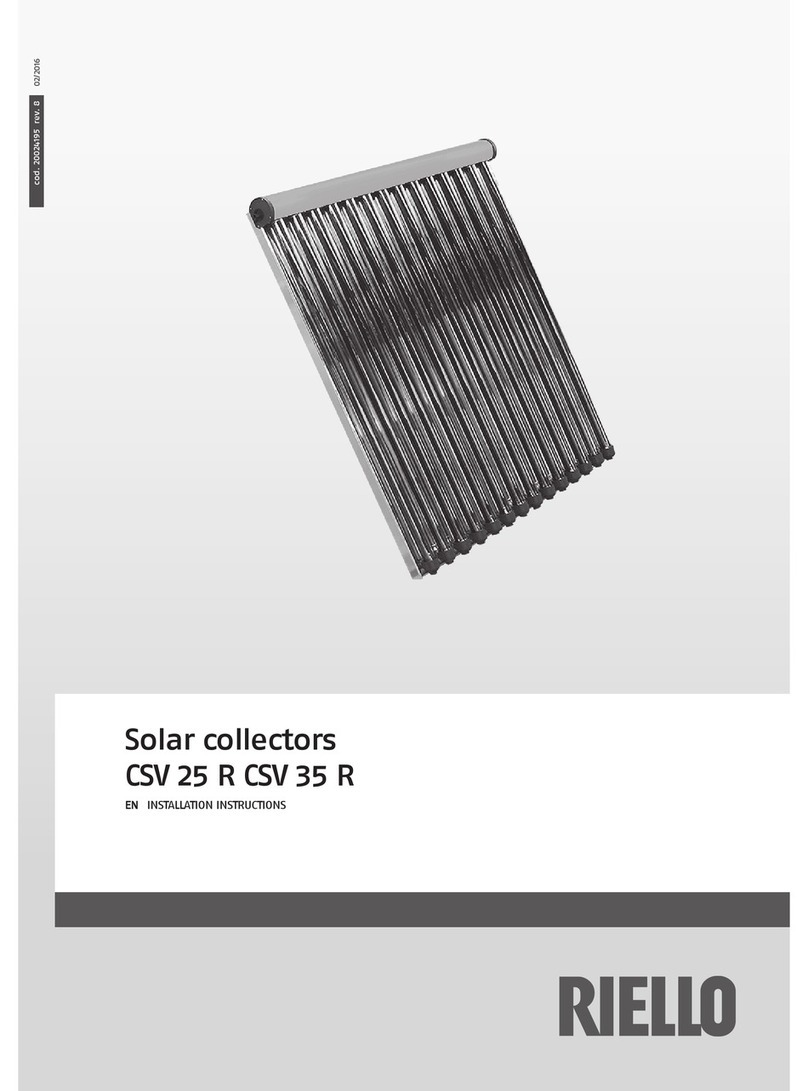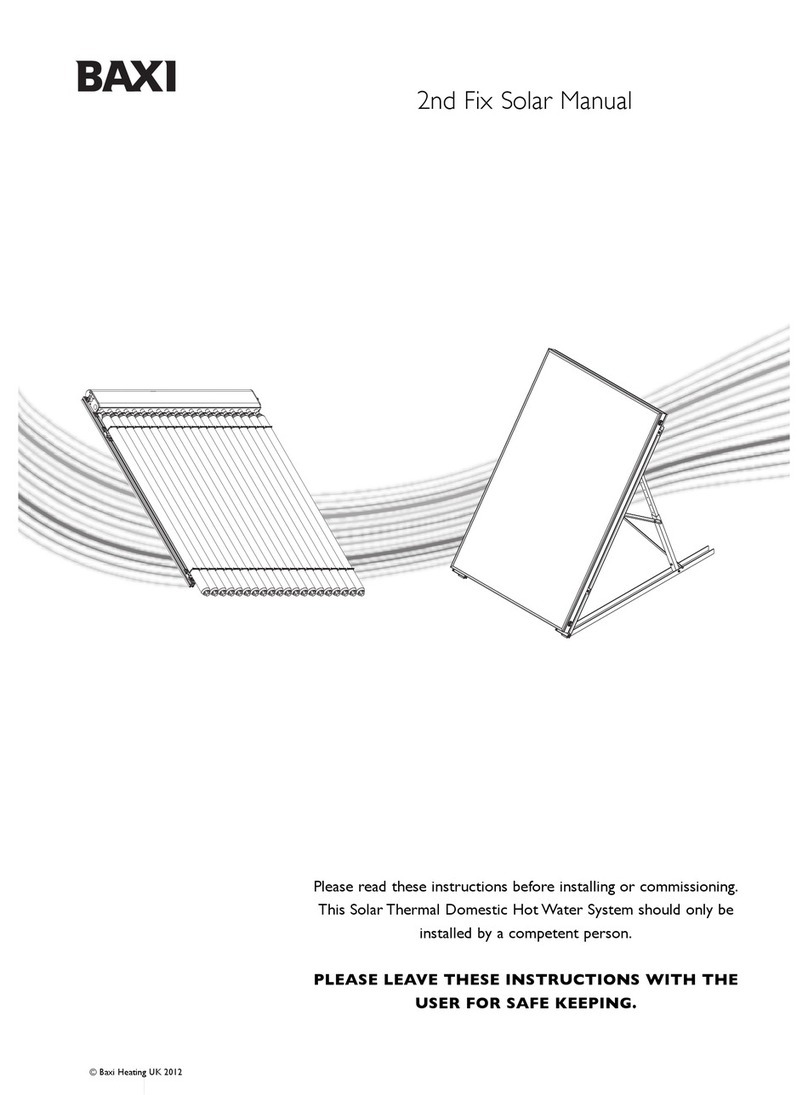Romstal Collector 2.0 User manual

SOLAR COLLECTOR
EN INSTALLER MANUAL
[ EN ]

2
GENERAL INFORMATION
ACCESSORIES
For a complete list of accessories and details of their compatibil-
ity, refer to the Catalogue.
Dear heating engineer,
We would like to congratulate you on having recommended our
Solar collector unit: a modern product that's capable of ensur-
This booklet provides the information necessary for a correct
and simple installation of the system, whatever your expertise
and technical competence.
Thank you again, and keep up the good work.
CONTENTS
The following symbols are used in this manual:
9 CAUTION! =
0 STOP! =
CONFORMITY
Solar collectors comply with EN 12975-1, ISO 9806 and Solar Key-
GENERAL INFORMATION
1 GENERAL SAFETY INFORMATION
9 Check that the product is complete, undamaged and as or-
dered as soon as you receive it. Report any discrepancies or
damage to the Romstal’s dealer who sold it.
9 -
ing engineer. On completion of the installation, the install-
er must issue the owner with a declaration of conformity
highest standards in compliance with the instructions pro-
vided
in this instruction manual, and that it conforms to all
applicable laws and standards.
9 This product must only be used for the purpose for which it
declines
all responsibility, contractual or other, for damage to prop-
erty or injury to persons or animals caused by improper inst-
allation, adjustment, maintenance or use.
9
heating engineer.
9 Solar collectors must be installed with the correct mounting
kit (which includes all necessary rails and brackets) as listed
in the Catalogue.
9
to protect the absorber against solar irradiation and prevent
the solar collector from becoming too hot if it is not going
to be put into service immediately. Fill the system, but do
place for longer than 12 months. Once removed, the pro-
of PVC.
2
1 General Safety Information .................... . . 2
2 Precautions................................ . . 3
3 Description of the appliance ................... . . 4
.............................. . . 4
5 System layout .............................. . . 5
....................... . . 5
7 Unpacking the product ....................... . . 7
8 Handling.................................. . . 7
9 Installation area ............................ . .8
............. . . 9
11 Hydraulic connections....................... . . 10
12 Exploded view ............................. . .11
14 Installation ............................... . . 13
29 Source water system........................ . . 28
30 Filling and emptying........................ . . 29
31 Device cleaning and maintenance ............. . . 29
32 Recycling and disposal ...................... . . 29
33 External maintenance....................... . . 30
us Romstal

3
GENERAL INFORMATION
2 PRECAUTIONS
9 Always wear safety goggles when drilling. Always wear safe-
ty shoes, cut-proof protective gloves and a safety helmet
when performing installation work.
9 Before beginning installation work on roofs, install the nec-
essary fall prevention and fall arrest devices and ensure that
all applicable safety standards are applied. Use only tools
and materials that conform to the safety standards that are
applicable in the place of work.
9 Use only overalls with harness (with lacing or restraining
belt, connection ropes or bands, fall dampeners, heat sinks)
-
ing and allowing operating in complete safety.
9 The use of ladders leaned against walls can lead to serious
falls if the ladder slips, slides of falls. When using ladders,
always ensure that they are stable, and that suitable ladder
stops are present. If possible secure the ladder with hooks.
Make sure that there are no live electrical wires near the
ladder.
0 Never attempt to install the system without using suitable
applicable occupational safety standards.
0 Do not touch the product when barefoot or wet if it has any
electrical accessories installed in it.
0
turning the mains power switch OFF to disconnect all elec-
0 If solar plant pressure decreases, it is forbidden to top up
with only water as there is a danger of freezing and over-
heating.
0 Do not dispose of packaging material into the environment,
or leave it within the reach of children, since it can become
a potential hazard. Dispose of packaging material in com-
pliance with applicable legislation.
9 The system must be installed by specialist personnel. Use
only the assembly material supplied with the solar collec-
tor. The supporting framework and all masonry or brickwork
loading, and must be suitable for the nature of the instal-
lation site.
9 The solar collector must only be installed on roofs or frames
that are strong enough to support its weight. The strength
expert in static loading before the solar collector is installed.
During this process, it is important to verify the suitability
the solar collector in place. An expert in static loading must
verify that the entire frame complies with relevant stand-
ards, especially in areas liable to snow and areas exposed
to high winds. Conditions (gusts of wind, formation of wind
vortices, etc.) at the point where the solar collector is to be
installed must be carefully considered since these can in-
crease the loads on the supporting structure.
9 Solar collector pipes must be connected through a (yel-
low-green) connector of at least 16 mm2Cu (H07 V-U o R)
to the potential compensation main bar. If a lighting rod is
already installed, collectors can be integrated in the exist-
ing system. If this is not the case, it is possible to carry out
earthing with a buried earth cable. The earth duct must be
laid outside the house. Furthermore, the earth cable must
be connected to the compensation bar through a duct hav-
ing the same diameter.
9 All pipes in the water circuit must be insulated in conform-
ity to relevant standards. Lagging and insulation must be
protected against damage by the weather and birds and
animals.
9 The collector is suitable for a minimum inclination of 15°, up
to a maximum of 75°.
9 This instruction manual is an integral part of the product. It
must be kept safe and must ALWAYS accompany the product,
even if it is sold to another owner or transferred to another
user or to another installation. If you lose this manual, or-
der a replacement immediately. Keep the product purchase
documents to be presented to
Romstal’s
authorised Technical
9 Size the solar expansion tank so as to ensure complete ab-
system, with reference to the prevailing regulations on the
-
might be generated during solar collector stagnation stage.
Proper size of expansion tank ensures setting off of all vol-
pressure increase. Limited pressure changes avoid reach-
drainage.
3

4
GENERAL INFORMATION
3 DESCRIPTION OF THE APPLIANCE
aluminium absorber, with vertical copper pipes welded onto it,
ending at their upper and lower ends, in two horizontal head-
-
zontal pipe grid.
The surface processing of the aluminium sheet is of selective
TINOX. These surfaces have the great advantage while absorb-
ing solar energy and operate as black bodies (high absorptivity),
when they radiate themselves, they operate as mirrors (mini-
mum radiation e
of the collector’s thermal losses.
• The copper grid consists of vertical Ø8 tubes, spaced at
85mm intervals and welded onto the 0,4 mm aluminium
sheet with Laser welding. The small distance between the
tubes, the thickness of the aluminium and the proper weld-
ing, maximizes the heat transfer from the heated alumini-
which circulates inside.
Ø22 diameter.
-
loy-steel frame, with 0,42mm thickness.
• On the front, there is a clear safety glass cover (low iron, mis-
-
ed alloy-steel frame, by injecting the polymeric material
Colofast® by BASF.
-
tion between glass and steel, robustness and forms a solid
peripheral structure for the upper section of the casing. It is
• On the back of the absorber, there is glass-wool thermal
insulation with 40 kgr/m3 density and 30mm thick.
• The operating pressure of the closed circuit of the collectors
can be 6 or 10 bar, depending on the design, considering that
collectors can withstand even higher pressures.
pitched tiled roofs, by using the appropriate support frames
that are available as accessories.
4 IDENTIFICATION
Data label
To be applied to the back of
the solar collector on istallation
GROSS AREA : 2.00M2
DIMENSIONS : 1235x1625x85mm
MAX OPER. PRESSURE : 10 Bar
STAGNATION TEMPERATURE : 180 °C
WEIGHT EMPTY : 29.15kg
PRODUCTION DATE : 2022
MAX GLYCOL CONCETRATION: 53%
Made in E.U
FLAT SOLAR PANEL
APERTURE AREA: 1.90M2
2201262500002382
SERIAL NUMBER
ABSORBER CAPACITY: 1.38 L
ABSORBER AREA: 1.90M2
GROSS AREA : 2.50 M2
DIMENSIONS : 1235x2020x85mm
MAX OPER. PRESSURE : 10 Bar
STAGNATION TEMPERATURE : 180°
C
WEIGHT EMPTY : 35.4 kg
PRODUCTION DATE : 2022
MAX GLYCOL CONCETRATION: 53%
Made in E.U
FLAT SOLAR PANEL
Data label
To be applied to the back of
the solar collector on istallation
APERTURE AREA: 2.38 M2
2201262500002140
SERIAL NUMBER
ABSORBER CAPACITY: 1.55 L
ABSORBER AREA: 2.37 M2
Collector 2.5
Collector 2.0
9 If these plates or any other means of clearly identifying the
product are defaced, removed or lost, proper installation
4

GENERAL INFORMATION
5 SYSTEM LAYOUT
Solar collector 2.5
Solar collector 2.0
1235
2020
85
(**)
(*)
Ventilation hole
Glass thickness
3,2 mm
Collector fitting
Ø 22 mm
collector
delivery
collector
return
The delivery and return must
be connected to opposite sides.
(*) Alternative collector return
(**) Alternative collector delivery
1235
1625
85
(**)
(*)
Ventilation hole
Glass thickness
Collector fitting
Ø 22 mm
collector
delivery
collector
return
The delivery and return must
be connected to opposite sides.
(*) Alternative collector return
(**) Alternative collector delivery
6 TECHNICAL SPECIFICATIONS
DESCRIPTION Collector 2.0 Collector 2.5
Total area 2,00 2,49 m2
1,91 2,39 m2
Effective absorption area 1,90 2,37 m2
22 22 Ø
29,15 35,4
1,38 1,55
2of collector (*) 50 50 l/(m2
2of collector (**) 30 30 l/(m2
2of collector 60 60 l/(m2
2of collector 20 20 l/(m2
3,2 3,2 mm
30 30 mm
Absorption 95 95 %
4 4 %
10 10 bar
Stagnation temperature 180 180
10 10
Installation -
Glass
Low Iron Prismatic Tempered Low Iron Prismatic Tempered
-
(**) medium/cold climatic bands
5

6
GENERAL INFORMATION
Collector
2.0
Collector
2.5 Units
(*) 0,762 0,770 -
2,99 3,18 W/(m2
dependence factor (a2) (*) 0,027 0,021 W/(m2 2)
2.
Pressure drop in solar collectors (*)
PRESSURE DROP (mbar)
Collector 2.5
WIND AND SNOW LOADS ON COLLECTORS
9
basis
Collector 2.0
Florate (l/h) Florate (l/h)

7
INSTALLATION
7 UNPACKING THE PRODUCT
Solar collectors are supplied in packages containing 1, 2 or 5
panels
Pallet contents:
collector
document envelopes containing instruction manual
9 The instruction manual is an integral part of the solar con-
nector. Once located, read it thoroughly and keep it safe.
9 STORE IN A DRY PLACE AND DO NOT EXPOSE TO DIRECT SUNLIGHT
UNTIL THE TIME OF INSTALLATION! The packaging is not de-
signed to protect the product against rain or humidity. It can
also degrade if exposed to direct sunlight. Failure to comply
with these precautions could lead to irreparable damage to
the product.
Installation
8 HANDLING
Separate the solar collector from the wooden pallet by
Once you have removed the outer packaging, proceed as follows
to unpack and handle the solar collector:
Tilt the solar collector slightly and grip it at the four points
shown (A) to lift it.
the solar collector on to the roof.
Data label
GROSS AREA : 2.00M2
DIMENSIONS : 1235x1625x85mm
MAX OPER. PRESSURE : 10 Bar
STAGNATION TEMPERATURE : 180 °C
WEIGHT EMPTY : 29.15kg
PRODUCTION DATE : 2022
MAX GLYCOL CONCETRATION: 53%
Made in E.U
FLAT SOLAR PANEL
APERTURE AREA: 1.90M2
2201262500002382
SERIAL NUMBER
ABSORBER CAPACITY: 1.38 L
ABSORBER AREA: 1.90M2
AA
AA
9 -
able safety devices.
0 Do not dispose of packaging material into the environment,
or leave it within the reach of children, since it can become
a potential hazard. Dispose of packaging material in com-
pliance with applicable legislation.
0

8
INSTALLATION
9 INSTALLATION AREA
Select the best possible orientation for the solar collectors (ide-
ally facing south). Avoid positions that are shaded by plants,
trees, buildings or hills, etc. during the day.
In systems in which the summer load is predominant (produc-
tion of domestic hot water) aim the collector from east to west
with a variable inclination from 20° to 60°. The ideal direction
-
cation -10°. If the system sustains the greatest thermal load in
the winter (as in systems that combine domestic hot water pro-
duction with central heating), install the collectors facing south
(or south-east or south-west) at an angle greater than 35°. The
-
tude of the location plus 10°.
Remove all gravel and detritus from the surface on which the
system is to be installed.
solar water heating systems.
-
ture of the roof. It is necessary to check and possibly adapt all
the roof elements to prevent any seepages or damages caused
by wind and/or snow.
>1,5 m
>1,5 m
9 Collectors must be installed at a safety distance from active
laws and regulations in force in the country of installation
-
to the action of the wind and of the lowering in height due to
thermal conditions is as follows:
H
Voltage range H
<1 kV 3 m
1 ÷ 30 kV 3,5 m
30 ÷ 132 kV 5 m
< 132 kV 7 m
9 Contact with open, live electrical wires may lead to electro-
cution and may even be fatal.
9 Non-electrical works near live unprotected electric ducts
with which a contact is possible must be carried out in ac-
cordance with laws and regulations in force in the country
of installation.

9
INSTALLATION
10 INSTALLATION ON FLAT ROOFS WITH BALLAST
For checks of allowable loads contact a specialised technician.
Wind speed, km/h Inclination angle of solar
collectors
Mass in kg, distributed on the various bearing points, to
secure a collector from wind lifting
100 30°-45° 135
130 30°-45° 255
150 30°-45° 355
kg

10
INSTALLATION
11 HYDRAULIC CONNECTIONS
9 During installation, pay attention to the position of the probe with respect to the collector. The collector probe must always be
When tightening a fitting,
HOLD THE OPPOSITE
FITTING STEADY WITH
A SECOND TOOL
to avoid damage!
Hot water from collector
Cold water from collector
compression fitting
cross with air vent and sensor hose
compr
male fitting
compression brass cup
compression brass cup
male fitting
-
The positioning of the socket on the collector allows the maximum transfer of heat accumulated in the panels.
It is also possible to connect more than one line of solar collectors, both in series (provided that the number of solar collectors
does not exceed 10 units per each series) and in parallel. In any case the circuit must be hydraulically balanced (see the following
example diagrams).

11
INSTALLATION
12 EXPLODED VIEW
STAND-ALONE COLLECTOR FLAT ROOF WITH ARRAY

12
INSTALLATION
2PCS
2.5MM SHEET STEEL
4 PCS
13 EXPLODED VIEW
STAND-ALONE COLLECTOR FLAT ROOF

13
INSTALLATION
14 INSTALLATION
STAND-ALONE COLLECTOR INCLINED ROOF
CAUTION: Check the capacity of the roof structure to bear the solar heater load in operation with the
constructor of the building or contact the local authorities.
DIMENSIONS
(mm)
2.0 2.5 2x2.0 2x2.5
A1090 1090 1090 1090
B2000 2400 2000 2400
STEP 1
Uncover the roof tiles at the lowest and the highest part of the area where the collectors will be in-
stalled. Install the 4 AGG brackets (or the AT – triangular type or the AR – special screw, if needed)
on the vertical, load-bearing beams with appropriate screws, as shown on the drawing above (pic.2).
Make sure that the distances A and B (pic.1) between any of the top holes on each bracket are set ac-
cording to Table 2. You may take advantage of the fact that there are 3 holes on the top of each bracket
to accommodate for different tile sizes. .
TABLE 2
PICTURE 1
A
B
PICTURE 2

14
INSTALLATION
15 INSTALLATION
STAND-ALONE COLLECTOR INCLINED ROOF
STEP 2
Replace the roof tiles and install the two longitudinal base sections onto the AGG brackets. Make use
of the telescopic feature of the sections to adjust them to the appropriate length.
C

15
INSTALLATION
16 INSTALLATION
STAND-ALONE COLLECTOR INCLINED ROOF
STEP 3
Install the two L beams supporting the collector. The distance C between the vertical mounting faces
bottom beam and slide the top beam upwards to ease collector installation.
STEP 4
Place the collector(s) on the base assembly. Tighten the bottom securing bolts against the bottom sup-
port beam.
DIMENSIONS
(mm)
2.0 2.5 2x2.0 2x2.5
C1600 1994 1600 1994

16
INSTALLATION
17 INSTALLATION
STAND-ALONE COLLECTOR INCLINED ROOF
STEP 5
Slide the top support beam against the collector and tighten the support bolts. Tighten the support
beam onto the longitudinal base sections.

17
INSTALLATION
18 INSTALLATION
STAND-ALONE COLLECTOR
STEP 1
the length of the collector. The dimension above corresponds to the P2.5 collector. The P2.0 collector
into the system so that different tile sizes and rafter spacings can be accommodated. The dimensions
above are the most common dimensions for Roman style tiles.
STEP 2
Place the assembled base on the roof and remove as many tiles as necessary at the viccinity where the
supports are so that you may observe the roof support structure and adjust the installation accordingly.
There are alternative mounting points on both directions on the longitudinal beams and on the middle
in case the rafter spacing is inconvenient. Make sure that the roof structure can support the collector
array and the stresses induced and that the points of contact are sound. Mark and drill the holes for
the roof dowels.
9 Do not remove the collector cover!

18
INSTALLATION
19 INSTALLATION
STAND-ALONE COLLECTOR
STEP 3
Install all roof dowels, ensure that the system is stable and geometrically correct, tighten all bolts and
replace the roof tiles.
9 Do not remove the collector cover!
STEP 4

19
INSTALLATION
20 INSTALLATION
STAND-ALONE COLLECTOR
STEP 5
place. Take care not to damage the absorber tubes. Install the collector bolts. Tighten the hydraulic
connections and then tighten the collector bolts.
NOTE
Arrays of more than two collectors may be created with the ARRAY module as shown
above. The array starts with the twin collector system that is shown in the steps above
ARRAY module during the above steps.
9 Do not remove the collector cover!

20
INSTALLATION
21 INSTALLATION
STAND-ALONE COLLECTOR FLAT ROOF
30 DEGREE
SETTING
45 DEGREE
SETTING
STEP 1
-
ment is possible.
STEP 2
Determine the position of the system on the roof according to the guidelines at the relevant section of
this manual. Mark the position of the holes for the front two feet at 1245mm apart and drill appropriate
holes for the anchors.
This manual suits for next models
1
Table of contents

